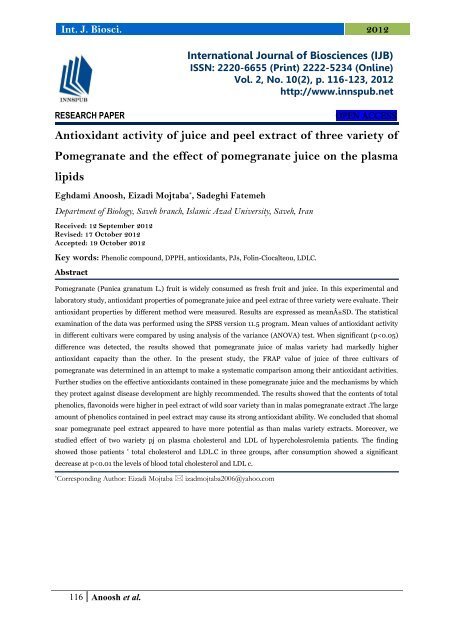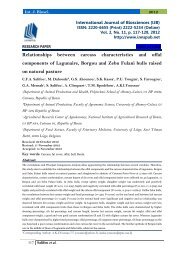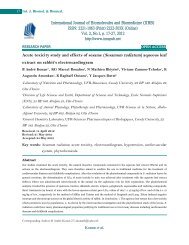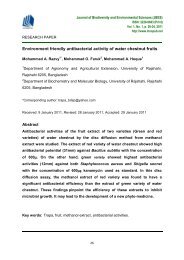Full Text - International Network for Natural Sciences | INNSPUB
Full Text - International Network for Natural Sciences | INNSPUB
Full Text - International Network for Natural Sciences | INNSPUB
You also want an ePaper? Increase the reach of your titles
YUMPU automatically turns print PDFs into web optimized ePapers that Google loves.
Int. J. Biosci. 2012<br />
RESEARCH PAPER OPEN ACCESS<br />
Antioxidant activity of juice and peel extract of three variety of<br />
Pomegranate and the effect of pomegranate juice on the plasma<br />
lipids<br />
Eghdami Anoosh, Eizadi Mojtaba * , Sadeghi Fatemeh<br />
Department of Biology, Saveh branch, Islamic Azad University, Saveh, Iran<br />
Received: 12 September 2012<br />
Revised: 17 October 2012<br />
Accepted: 19 October 2012<br />
Key words: Phenolic compound, DPPH, antioxidants, PJs, Folin-Ciocalteou, LDLC.<br />
Abstract<br />
Pomegranate (Punica granatum L.) fruit is widely consumed as fresh fruit and juice. In this experimental and<br />
laboratory study, antioxidant properties of pomegranate juice and peel extrac of three variety were evaluate. Their<br />
antioxidant properties by different method were measured. Results are expressed as mean±SD. The statistical<br />
examination of the data was per<strong>for</strong>med using the SPSS version 11.5 program. Mean values of antioxidant activity<br />
in different cultivars were compared by using analysis of the variance (ANOVA) test. When significant (p
Introduction<br />
Punica granatum L. (Punicaceae) is a deciduous<br />
shrub or small tree originally distributed in Iran and<br />
Afghanistan, and was introduced into China in the<br />
2nd century BC. The extracts from this plant (juices,<br />
seed oil and peel) have been reported to exhibit<br />
strong antioxidant activity (Lansky et al., 2007).<br />
Pomegranate leaf extract has shown free radical<br />
scavenging activity and antioxidant effects in vitro as<br />
well as numerous pharmacological activities, such as<br />
antitumor, antibacterial, astringent, anti-obesity and<br />
antidiarrheal activity (Adhami et al., 2006; Lei et al.,<br />
2007).<br />
Antioxidants from leaf tissue have been isolated and<br />
identified and include flavone glycosides and gallo-<br />
and ellagitannins. The nutritional and antioxidant<br />
characteristics of pomegranate leaves have increased<br />
recent interest in their use as a beneficial source of<br />
secondary metabolites. As such, pomegranate leaves<br />
have been developed into a series of commercial<br />
products including green tea and other teas which<br />
are consumed in China, and have been included in<br />
nutrition capsules in the USA. Physical and chemical<br />
changes in pomegranate leaves have been reported<br />
(Bacha, 1975).<br />
The seasonal trends in nitrogen and carbohydrate<br />
contents in the leaves of ‘Banati’ pomegranate trees<br />
were studied during two successive growing seasons.<br />
The nitrogen content (% and mg/leaf) decreased<br />
gradually during the growing season of 1972 and<br />
1973, while, the total sugars (%) in the leaves<br />
fluctuated and did not show a discernable trend over<br />
the 2-year observation period. The starch content in<br />
the leaves tended to decrease from May to August<br />
and then increased until the end of the growing<br />
season in both years (Lihua et al., 2010).<br />
Pomegranate is a good example <strong>for</strong> this type of fruits.<br />
Pomegranate peels constitute approximately 40% of<br />
the whole fruit and are rich in ellagic acid derivatives<br />
such as the ellagitannins, punicalagin, and penicillin.<br />
In addition, some ellagic acid derivatives (ellagic acid<br />
hexoside, -pentoside, etc.) are also present, although<br />
in lesser amounts. The most abundant of these<br />
polyphenols is punicalagin which is extracted from<br />
pomegranate juice during juice processing and which<br />
is responsible <strong>for</strong> more than 50% of the pomegranate<br />
juice’s potent anti-oxidant activity (Mustafa et al.,<br />
2010).<br />
Plant based antioxidants are extracted from raw<br />
materials or waste products of food industry by<br />
organic solvents such as methanol, diethyl ether, and<br />
acetone. Methanol is an effective extractant <strong>for</strong> a<br />
broad range of polyphenols; there<strong>for</strong>e it is a<br />
frequently used solvent <strong>for</strong> both a laboratory scale<br />
and an industrial extraction process. Methanol is<br />
cheap and easily accessible and the manufacturing of<br />
herbal medicine usually uses methanol as a solvent<br />
to extract natural ingredients, a fact that will also<br />
concern us about the residual level of methanol in<br />
these products (Wang et al., 2004).<br />
Pomegranate juice is nutritionally an important<br />
beverage since it is consumed frequently <strong>for</strong> its<br />
phenolics compounds (such as anthocyanins, ellagic<br />
acid, phytoestrogenic flavonoids and tannins). In the<br />
past decade, numerous studies on the antioxidant<br />
activity have shown that pomegranate juice contains<br />
high levels of antioxidants - higher than most other<br />
fruit juices and beverages Besides these findings,<br />
some clinical research studies suggest that<br />
pomegranate juice changes the blood parameters<br />
such as LDL, HDL, and cholesterol increase the<br />
prostate specific antigen (PSA), and may be helpful<br />
against heart disease, Alzheimer’s disease. Phenolic<br />
compounds including flavonoids and flavonoids are<br />
widespread in plants and they are important in<br />
contributing the flavor and color of many fruits and<br />
vegetables. They are C15 compounds of 2 Phenolic<br />
rings connected by a 3-carbon unit, and grouped<br />
according to presence of different substituents on the<br />
rings and the degree of ring saturation. They are<br />
frequently attached with sugars moiety to increase<br />
their water-solubility .Flavonoids extracted from<br />
pomegranate showed strong anti-oxidant activity<br />
(Mustafa et al., 2010; Yunfeng et al.,<br />
2006).Currently, there is great interest in finding
Int. J. Biosci. 2012<br />
antioxidants from natural sources to minimize<br />
oxidative damage to cells. Oxidative damage is<br />
caused by free radicals and reactive oxygen species,<br />
mostly generated endogenously. Pomegranate fruit<br />
has valuable compounds in different parts of the fruit<br />
whose functional and medicinal effects such as<br />
antioxidant, anticancer and anti-atherosclerotic<br />
effects have been confirmed. Pomegranate juice is<br />
nutritionally an important beverage since it is<br />
consumed frequently <strong>for</strong> its Phenolic compounds<br />
(such as anthocyanins, ellagic acid, phytoestrogenic<br />
flavonoids and tannins, (Bazzano et al., 2002; Block<br />
et al., 1992). Phenolic compounds could be a major<br />
determinant of antioxidant potentials of foods, and<br />
could there<strong>for</strong>e be a natural source of antioxidants.<br />
Phenolic acids consist of two subgroups, i.e., the<br />
hydroxybenzoic and hydroxycinnamic acids (table 1<br />
and table 2). Hydroxybenzoic acids include gallic, p-<br />
hydroxybenzoic, protocatechuic, vanillic and syringic<br />
acids, which in common have the C6–C1 structure.<br />
Hydroxycinnamic acids, on the other hand, are<br />
aromatic compounds with a three-carbon side chain<br />
(C6–C3), with caffeic, ferulic, p-coumaric and sinapic<br />
acids being the most common (Knekt et al., 1997).<br />
Pomegranate juice consumption <strong>for</strong> 3 years on<br />
patients with carotid artery stenosis and reduces<br />
common carotid intima-media thickness, blood<br />
pressure and LDL oxidation. Dietary<br />
supplementation with polyphenolic antioxidants to<br />
animals was shown to be associated with inhibition<br />
of LDL oxidation and macrophage foam cell<br />
<strong>for</strong>mation, and attenuation of atherosclerosis<br />
development (Aviram et al., 2004).<br />
Moreover ,we investigated the effects of<br />
pomegranate juice (PJ, which contains potent<br />
tannins and anthocyanins,pj) consumption by<br />
hyperlipidemia patients, the aim of our study is to<br />
estimate the effect of two variety pomegranate juice<br />
consumption <strong>for</strong> four weeks by hypercholesrolemia s’<br />
patients and comparing the blood levels of LDL<br />
cholesterol in patients be<strong>for</strong>e and after pj<br />
consumption .<br />
118<br />
Baboli et al.<br />
Materials and methods<br />
Plant collection<br />
The pomegranates were collected in Novembers<br />
2010 from one village of Saveh, in the Mrkazy<br />
Province of Iran. The area falls within the latitudes<br />
35°.15' and longitudes 49°. 45' and the altitude of<br />
area is 1680 m.<br />
Chemicals<br />
1, 1-Diphenyl-2-picryl hydrazyl (DPPH) and<br />
quercetin were purchased from Sigma Chemical Co.<br />
(St., Louis, USA). Gallic acid, Folin Ciocalteu<br />
reagent, trifluoroacetic acid (TFA) and methanol<br />
were purchased from Merck Co. (Germany).<br />
Sample preparation of peel<br />
The pomegranate peel samples were first ground to<br />
fine powder. For water extraction, 0.5 g of the fine<br />
powder was extracted with 10 ml of ultra-filtered<br />
water at 100 °C <strong>for</strong> 30 min in a water bath. For<br />
methanol extraction, 0.5 g of the powder was<br />
extracted with 10 ml of 80% methanol at 40 °C <strong>for</strong><br />
24 h. The samples were then cooled down to room<br />
temperature and centrifuged at 4500 rpm <strong>for</strong> 15 min.<br />
The supernatant was recovered and used <strong>for</strong> the<br />
DPPH assay and total phenolic analysis. We used<br />
HPLC analyzing <strong>for</strong> polyphenol types determination.<br />
Sample preparation of juice<br />
Approximately 5 kg of pomegranate fruit was<br />
sampled <strong>for</strong> each cultivar (Malas and Saveh Black<br />
Leather). After discarding injured and sunburnt<br />
fruits, pomegranate fruits were peeled and the skins<br />
covering the seeds were removed manually. The juice<br />
of the seeds was extracted with a pilot plant<br />
packaged-type press (Bucher, Switzerland). The<br />
juices were kept at -20 C 0 until analyzed <strong>for</strong> no<br />
longer than three months. Be<strong>for</strong>e the experiments,<br />
PJs were defrosted and then centrifuged at 4000 g<br />
<strong>for</strong> 15 min at +4C 0 in order to remove water<br />
insoluble particles<br />
Determination of total phenolic content<br />
The total phenolic content of the pomegranate peel<br />
Extracts and juice was determined using the Folin-<br />
Ciocalteu reagent (Wolfe et al., 2003) .The reaction
Int. J. Biosci. 2012<br />
mixture contained: 200 μl of diluted peel extract and<br />
juice, 800 μl of freshly prepared diluted Folin<br />
Ciocalteu reagent and 2 ml of 7.5% sodium<br />
carbonate. The final mixture was diluted to 7 ml with<br />
deionized water. Mixtures were kept in dark at<br />
ambient conditions <strong>for</strong> 2 h to complete the reaction.<br />
The absorbance at 765 nm was measured. Gallic acid<br />
was used as standard and the results were expressed<br />
as mg gallic acid (GAE)/g peel extract and juice.<br />
Determination of total flavonoid content<br />
Total flavonoid content was determined using<br />
aluminium chloride (AlCl3) according to a known<br />
method, (Ordon et al., 2006) using quercetin as a<br />
standard. The plant extract and juice (0.1 ml) was<br />
added to 0.3 ml distilled water followed by 5%<br />
NaNO2 (0.03 ml). After 5 min at 25°C, AlCl3 (0.03<br />
ml, 10%) was added. After further 5 min, the reaction<br />
mixture was treated with 0.2 ml of 1 mM NaOH.<br />
Finally, the reaction mixture was diluted to 1 ml with<br />
water and the absorbance was measured at 510 nm.<br />
The results were expressed as mg quercetin (QE)/g<br />
peel extract and juice.<br />
Antioxidant activity<br />
DPPH (2, 2'-diphenyl-1-picrylhydrazyl)<br />
The antioxidant activity was tested by the DPPH (2,<br />
2'-diphenyl-1-picrylhydrazyl) free radical scavenging<br />
method <strong>for</strong> each pomgranate sample. Then, we also<br />
prepared a dilution 1 M of DPPH. The absorbance of<br />
a mixture of 1 ml of sample and 1 ml of the DPPH<br />
solution was measured at 517 nm. The radical<br />
scavenging activity was calculated from the<br />
equation:Percentage of radical scavenging activity =<br />
(Abs control - Abs sample)/Abs control Χ 100.<br />
Ferric reducing antioxidant power (FRAP) assay<br />
FRAP assay is based on the ability of antioxidants to<br />
reduce Fe3+ to Fe2+ in the presence of 2,4,6-tri(2-<br />
pyridyl)-s-triazine (TPTZ), <strong>for</strong>ming an intense blue<br />
Fe2+-TPTZ complex with an absorption maximum at<br />
593 nm. This reaction is pH-dependent (optimum<br />
pH 3.6). The absorbance decrease is proportional to<br />
the antioxidant content (Benzie et al., 1996) 0.2 ml<br />
of the extract is added to 3.8 ml of FRAP reagent (10<br />
119<br />
Baboli et al.<br />
parts of 300 Mm sodium acetate buffer at pH 3.6, 1<br />
part of 10.0 mM TPTZ solution and 1 part of 20.0<br />
mM FeCl3. 6H2O solution) and the reaction mixture<br />
is incubated at 37°C <strong>for</strong> 30 min and the increase in<br />
absorbance at 593 nm is measured. FeSO4 is used<br />
<strong>for</strong> calibration. The antioxidant capacity based on the<br />
ability to reduce ferric ions of sample is calculated<br />
from the linear calibration curve and expressed as<br />
mmol FeSO4 equivalents per gram of sample.<br />
Ascorbic acid, quercetin, can be used as a positive<br />
control.<br />
Clinical investigation<br />
in this investigation , patients were divided in three<br />
groups with twelve patients <strong>for</strong> each group .the<br />
treatments were including : 1-using malas variety of<br />
pomegranate juice 2- black variety of pomegranate<br />
juice 3- drug (levustatine).the levels of blood LDL.C<br />
in different exprements,be<strong>for</strong>e and after<br />
consumption of treatments were measured. We used<br />
venous blood sampling <strong>for</strong> fasting blood LDL<br />
cholesterol .These sample were collected in be<strong>for</strong>e<br />
and after consumption treatment. Serum was<br />
separated by centrifugation (10 minute, 1500 rpm).<br />
Serum LDL cholesterol levels were measured with<br />
the use of enzymatic LDL kit (zist shimi) by unic<br />
spectrophotometer .fresh PJ (black and malas<br />
variety) was used in this study. Pomegranates were<br />
hand-picked, washed, chilled to 4°C. The fruit was<br />
then crushed, squeezed. The PJ was filtered, and<br />
stored at -20°C until use (only 1-2 day).<br />
Administration of levustatine (cholesterol lowering<br />
drug by enzyme inhibition) to another group.<br />
Results and discussion<br />
All the analysis was per<strong>for</strong>med in triplicate. Results<br />
were expressed as means ± standard deviation.<br />
Descriptive statistical analysis, Pearson correlation<br />
coefficients, one-way analysis of variance (ANOVA)<br />
were per<strong>for</strong>med using SPSS .extract and juice of<br />
three variety of pomegranate showed scavenging<br />
effects against DPPH radical. The hierarchy <strong>for</strong><br />
antioxidant capacity with respect to their EC50<br />
values was peel aqueous extract > aqueous juice<br />
.Correlation coefficient showed that total Phenolic
Int. J. Biosci. 2012<br />
content was responsible <strong>for</strong> antiradical efficiency in<br />
peel extracts. The antioxidant and total Phenolic<br />
content levels are also positively and significantly<br />
correlated our results strongly suggested peel<br />
extracts and juice of pomgranate can be promising<br />
120<br />
Baboli et al.<br />
sources of potential antioxidants. The peel extracts of<br />
this plant had not significantly difference in ferrous<br />
reducing antioxidant power (FRAP) relative to<br />
aqueous juice.<br />
Table 1. Compairing (Mean±sd) ,cholesterol and LDLcholestrol in be<strong>for</strong>e and after treatment.<br />
Variety of Ch(Mean±sd)be<strong>for</strong>e<br />
pomegranate consumption<br />
SBL* pom<br />
juice<br />
247.00± 10.758<br />
Malas pom<br />
juice<br />
263.58±10.759<br />
levustatine 265.25±10.758<br />
Ch(Mean±sd)after<br />
consumption<br />
243.75± 10.758<br />
225.75±10.759<br />
208.42±10.759<br />
LDL(Mean±sd)be<strong>for</strong>e<br />
consumption<br />
158.25±10.758<br />
150.50±10.758<br />
138.33±13.64<br />
LDL(Mean±sd)after<br />
consumption<br />
130.50±10.758<br />
130.92±10.759<br />
111.58±13.30<br />
Table 2. total : Total phenolic ,flavonoids contents and antioxidant activities of juice and aqueous extract of<br />
pomegranate.<br />
Variety:wild (soar<br />
shomal)<br />
Phenolic content(mg<br />
GAL/g)<br />
Flavonoids<br />
content((QE)/g)<br />
Antioxidant activity<br />
By DPPH<br />
(Inhibition%)<br />
Antioxidant (FRAP)<br />
juice 92.2±0.04 36.7 ± 0.05 38.3±0.15 98.02 ± 0.5319<br />
peel extract 330.2±0.04 110.2±0.03 69.12 ±0.15 171.08 ± 0.53<br />
Each value in the table was obtained by calculating average of three experiments ą standard deviation.<br />
Table 3. Total phenolic ,flavonoids contents and antioxidant activities of methanol and aqueous extract of<br />
Stachys inflate.<br />
Variety:malas<br />
pomegranate<br />
Phenolic content(mg<br />
GAL/g)<br />
Flavonoids<br />
content((QE)/g)<br />
Antioxidant activity<br />
By DPPH<br />
(Inhibition%)<br />
Antioxidant (FRAP -<br />
mmol/l)<br />
juice 79.2±0.04 36.7 ± 0.05 48.3±0.15 109 ± 0.9<br />
Peel extract 271.4±15.2 83.2±3.8 77 ±0.35 141.08 ± 8.53<br />
Each value in the table was obtained by calculating average of three experiments ą standard deviation.<br />
Table 4. Total phenolic ,flavonoids contents and antioxidant activities of methanol and aqueous extract of<br />
Stachys inflate.<br />
Variety:saveh black Phenolic content(mg<br />
GAL/g)<br />
Flavonoids<br />
content((QE)/g)<br />
Antioxidant activity<br />
By DPPH<br />
(Inhibition%)<br />
Antioxidant<br />
(FRAP:mmol/l)<br />
juice 40.2±0.1 16.4 ± 2.5 32±0.52 7.2 ± 9.25<br />
Peel extract 283.2±14.2 69.2±4.2 75±2.15 161± 8.53<br />
Each value in the table was obtained by calculating average of three experiments ą standard deviation.<br />
The statistical examination of the data was<br />
per<strong>for</strong>med using the SPSS version 11.5 program.<br />
Mean values of antioxidant activity in different<br />
cultivars were compared by using analysis of the<br />
variance (ANOVA) test. When significant (p
Int. J. Biosci. 2012<br />
attempt to make a systematic comparison among<br />
their antioxidant activities. Further studies on the<br />
effective antioxidants contained in these<br />
pomegranate juice and the mechanisms by which<br />
they protect against disease development are highly<br />
recommended. The results showed that the contents<br />
of total phenolics, flavonoids were higher in peel<br />
extract of wild soar variety than in malas<br />
pomegranate extract .The large amount of phenolics<br />
contained in peel extract may cause its strong<br />
antioxidant ability.<br />
Fig. 1. Compairing (Mean±sd) , LDLcholestrol in<br />
be<strong>for</strong>e and after treatment.<br />
Administration of (black and malas) PJ to two<br />
groups (12 patients in each group) 200 ml/day <strong>for</strong> 4<br />
week, had significant effect on the plasma lipid,<br />
including total cholesterol and LDL-cholesterol (Fig<br />
1) .LDL cholesterol of two groups were measured<br />
be<strong>for</strong>e and after consumption of treatments. Means<br />
of be<strong>for</strong>e and after was compared in each group.<br />
Black and malas pomegranate juice consumption<br />
decreased LDL cholesterol (P
Int. J. Biosci. 2012<br />
pomegranate juice can act as a free radical<br />
scavenger.<br />
We conclude that consumption of pomegranate<br />
juice may be proven beneficial in attenuation of<br />
atherosclerosis development, since it is associated<br />
with reduced oxidation of LDL, reduced uptake of<br />
oxidized LDL by macrophages, reduced oxidative<br />
state of LDL and reduced LDL aggregation. All<br />
these effects lead to a reduced cellular cholesterol<br />
accumulation and foam cell <strong>for</strong>mation, the hallmark<br />
of early atherosclerosis. Investigations of aviram,<br />
furham, esmailzadeh and Rosenblatt compatible<br />
with our study. We concluded That shomal soar<br />
pomegranate peel extract appeared to have more<br />
potential as than malas variety extracts.Moreover<br />
,we studied effect of two wariety pj on plasma<br />
cholesterol and LDL of hypercholesrolemia patiens.<br />
The finding showed those patients ' total cholesterol<br />
and LDL.C in three groups, after consumption<br />
showed a significant decrease at p
Int. J. Biosci. 2012<br />
Lei F, Zhang XN, Wang W, Xing DM, Xie<br />
WD, Su H, Du LJ. 2007. Evidence of anti-obesity<br />
effects of the pomegranate leaf extract in high-fat<br />
diet induced obese mice. Int. J. Obes 31, 1023–<br />
1029.<br />
Lihua Z, Yujiao G, Yuanhu Z, Jing L, Junwei<br />
Y. 2010. Changes in bioactive compounds and<br />
antioxidant activities in pomegranate leaves.<br />
Scientia Horticulturae 123, 543–546.<br />
Mustafa C, Yasar H. 2010. Pressurised water<br />
extraction of polyphenols from pomegranate peels.<br />
Food Chemistry 123, 878–885.<br />
Ordon Ez AAL, Gomez JD, Vattuone MA, Isla<br />
MI. 2006. Antioxidant activities of Sechium edule<br />
(Jacq.) Swart extracts. Food Chemistry 97, 452–<br />
458.<br />
Sniderman A, Shapiro S, Marpole D, Skinner<br />
D, Teng B, Kwiterovick PO. 1980. Association of<br />
coronary atherosclerosis with<br />
hyperapobetalipoproteinemia: increased protein<br />
123<br />
Baboli et al.<br />
but normal cholesterol levels in human plasma low<br />
density beta lipoproteins. Proc. Natl. Acad. Sci. USA<br />
77, 604-608.<br />
Wang ML, Wang JT, Choong YM. 2004. A<br />
rapid and accurate method <strong>for</strong> determination of<br />
methanol in alcoholic beverage by direct injection<br />
capillary gas chromatography. Journal of Food<br />
Composition and Analysis 17, 187–196.<br />
Wolfe K, Wu X, Liu RH. 2003. Antioxidant<br />
activity of apple peels. Journal of Agriculture and<br />
Food Chemistry 51, 609–614.<br />
Yunfeng L, Changjiang G, Jijun Y, Jingyu W,<br />
Jing X, Shuang C. 2006. Evaluation of<br />
antioxidant properties of pomegranate peel extract<br />
in comparison with pomegranate pulp extract. Food<br />
Chemistry 96, 254–260.








